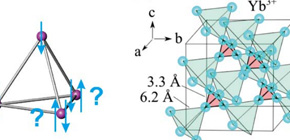
Challenging thermodynamics through regular tetrahedron spins
A new quantum state in breathing pyrochlore antiferromagnet observed
When four spins arranged in a tetrahedron face directions opposite each other, geometrical frustration arises between spins, and multiple states in which the material is stable are observed. However, the existence of such a state in matter is contradictory to the third law of thermodynamics, i.e., the entropy of a substance is zero when the absolute temperature is zero . Spin-frustrated materials are drawing attention in the field of condensed matter physics as a new state to be explored, because the state appears to be inconsistent with this third law of thermodynamics.
A group of researchers led by Associate Professor MASUDA Takatsugu at the Institute for Solid State Physics of The University of Tokyo, in cooperation with Osaka University, Australian Nuclear Science and Technology Organization (ANSTO), and National Cheng Kung University, performed inelastic neutron scattering (INS) experiments of breathing pyrochlore antiferromagnet (Ba 3 Yb 2 Zn 5 O 11 ), a kind of geometrically frustrated magnet. As a result, the magnetic spectrum was explained by a spin tetrahedron model with two stability states, and a result seemingly contradicting the third law of thermodynamics was obtained.
As the spin state of a material can be examined in inelastic neutron scattering (INS), this group measured the neutron spectrum of Ba 3 Yb 2 Zn 5 O 11 by a neuron chopper spectrometer with high resolution at various temperatures, observing four excited states. If this state is achieved, meaning each tetrahedron has two stable states and entropy is a finite value even at absolute zero temperature, this would contradict the third law of thermodynamics.
Then, based on the measured specific heat at very low temperature, this group estimated that entropy was 1K or less and found that it approached zero. It was also confirmed that a single state was selected; however, no specific heat changes suggesting the structural order among spin particles were observed. From this, it was clarified that a new spin liquid state emerged through an additional interaction in nature.
Using inelastic neutron scattering (INS) and thermodynamic properties measurements in combination, this group clarified that a new liquid state emerged in quantum breathing pyrochlore antiferromagnet (Ba 3 Yb 2 Zn 5 O 11 ). To know the details of this spin liquid, low-temperature, high resolution neutron experiments and further theory research based on real materials will be necessary. Detailed information about the spin liquid will be used for quantum computer devices.
Abstract
We study low-energy excitations in the quantum breathing pyrochlore antiferromagnet Ba 3 Yb 2 Zn 5 O 11 by a combination of inelastic neutron scattering (INS) and thermodynamical property measurements. The INS spectra are quantitatively explained by spin- 1 2 single-tetrahedron model having X X Z anisotropy and Dzyaloshinskii-Moriya interactions. This model has a twofold degeneracy of the lowest-energy state per tetrahedron and well reproduces the magnetization curve at 0.5 K and heat capacity above 1.5 K. At lower temperatures, however, we observe a broad maximum in the heat capacity around 63 mK, demonstrating that a unique quantum ground state is selected due to extra perturbations with an energy scale smaller than the instrumental resolution of INS.

Figure 1

Figure 2
To learn more about this research, please view the full research report entitled “ Low-Energy Excitations and Ground State Selection in Quantum Breathing Pyrochlore Antiferromagnet Ba 3 Yb 2 Zn 5 O 11 ” at this page of the Physical Review B website.
Related links
